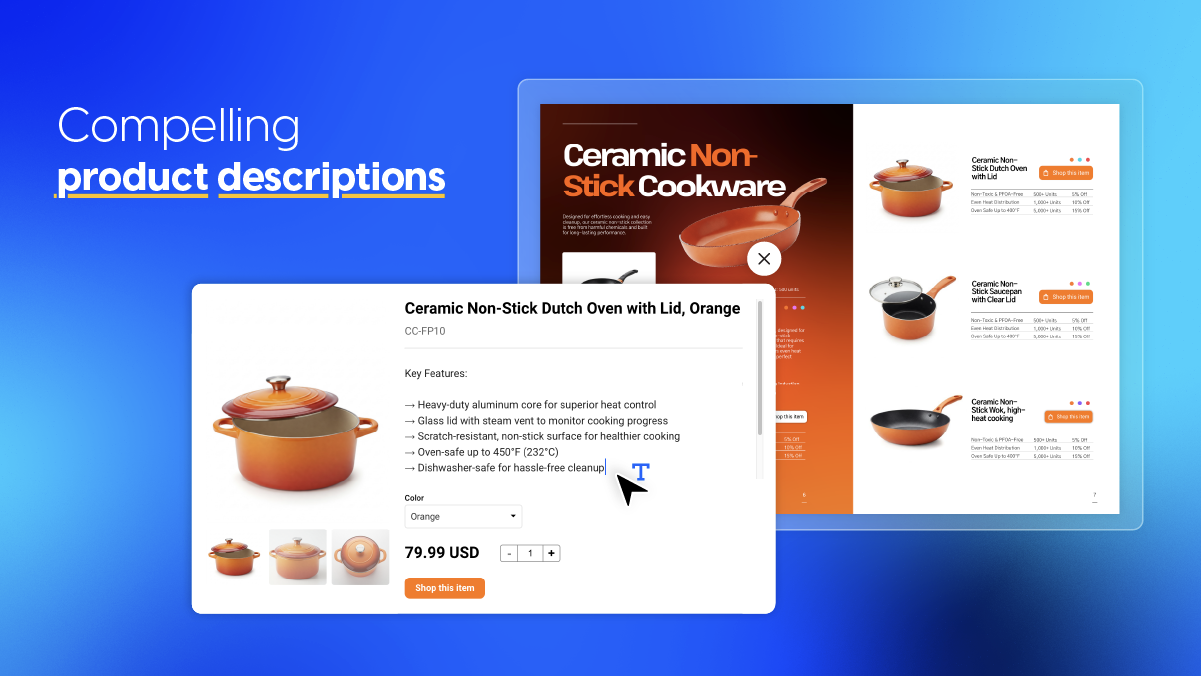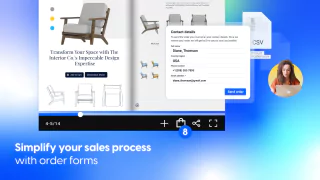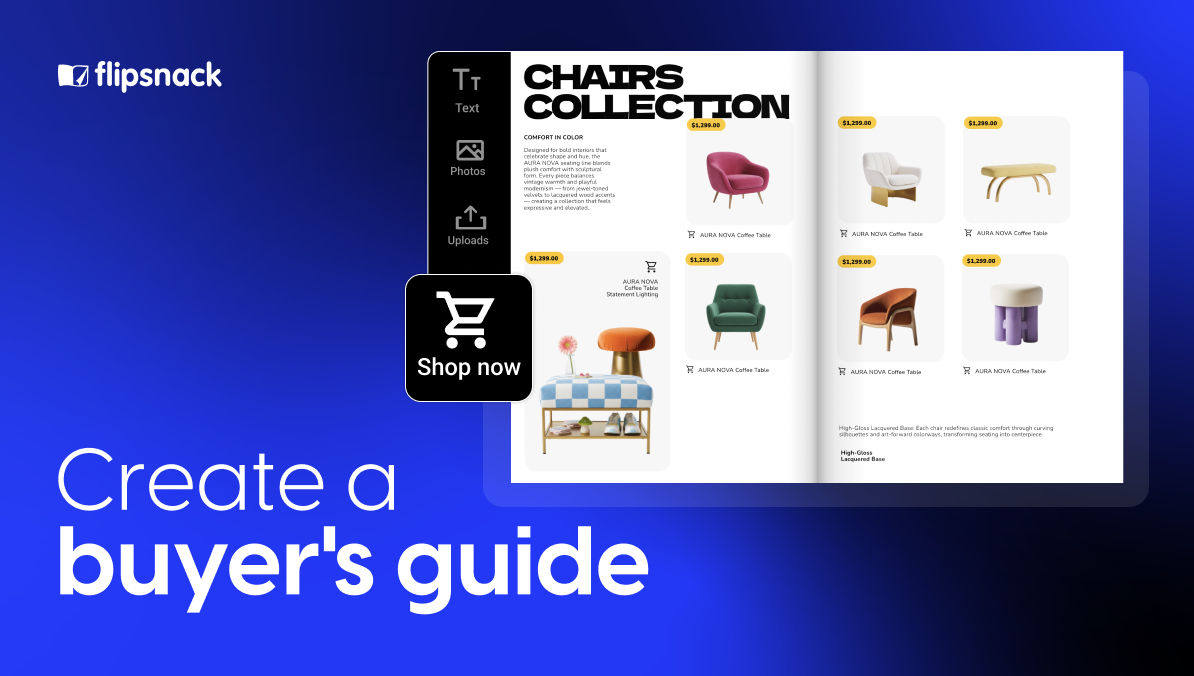How to write conversion-driven product descriptions
Last updated: March 17th, 2025
If you’re an e-commerce business owner, marketer, or retailer, you already know that product descriptions can make or break a sale. When customers browse your website or flip through your digital catalog, they’re drawn to the images first. But what happens next? They read the description.
A compelling company and product description does more than just describe—it persuades. It tells a story, highlights benefits, and convinces shoppers why they need this product in their lives. Whether you’re writing a shoe description example, a handbag description example, or anything in between, your words should be detailed, readable, and conversion-driven to boost sales.
So, how do you write product descriptions that don’t just list features but actually sell? Let’s break it down with actionable strategies, best practices, and real examples.

Table of contents
Why are product descriptions important?
Before diving into how to write a product description, let’s clarify why they matter so much.
1. They showcase your product’s value
A compelling product description does more than just list features—it highlights the benefits that resonate with potential buyers. Whether it’s a shoe description example that emphasizes comfort and durability or a handbag description example that speaks to elegance and functionality, a well-written description helps customers visualize the product in their lives. The more informed and connected they feel, the more likely they are to make a purchase.
2. They reflect your brand and audience
Your company and product description is an extension of your brand’s voice. A luxury handbag retailer, for instance, should use sophisticated, aspirational language, while a sports shoe brand might focus on performance and energy. Well-structured descriptions boost conversions by building trust and enhancing the shopping experience.
3. They improve search visibility and conversions
A great product description isn’t just about persuasion—it’s also about discoverability. When written according to SEO principles, descriptions help your e-commerce store rank higher on search engines, driving more traffic and increasing conversions. More sales signal to Google that your website is credible, leading to even better rankings—a win-win for your business.
Now that we understand their importance, let’s explore how to write conversion-driven, detailed, and readable product descriptions that sell.
How do you write a good product description?
Now that we’ve covered why product descriptions are essential, let’s focus on how to craft one that actually sells. A great description isn’t just about listing features—it’s about engaging your audience, improving search visibility, and boosting conversions.
There are at least 7 key elements of a well-structured, conversion-driven product description. Let’s break them down and explore the most effective strategies for how to write product descriptions that convert.
1. Focus on the benefits, not just the features
The biggest selling points of any product aren’t just what it does, but how it improves your customer’s life. While features provide technical details, benefits create an emotional connection and drive purchasing decisions.
As a business owner, it’s tempting to highlight all the impressive specs of your product. But customers care more about how it helps them. The key is to translate features into benefits.
For example:
Instead of saying a handbag is made of “premium Italian leather,” emphasize that it’s built to last for years, maintaining its elegance and durability.
Instead of describing a shoe as having a “memory foam sole,” say it provides all-day comfort, even on your busiest days.
Apple is a master of this approach. When launching the iPod Nano, they didn’t just say it had 10GB of storage. Instead, they answered a consumer need: “2,000+ songs right in your pocket.”
Another great example comes from ASOS, which blends features and benefits seamlessly:
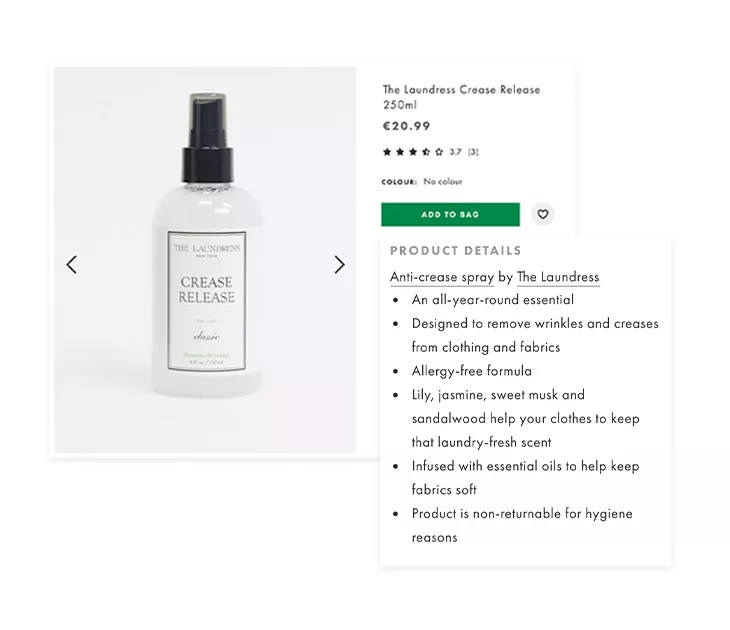
By framing your descriptions around benefits, you make your products more desirable, relatable, and ultimately, sellable.
2. Use a natural tone of voice
At its core, a product description is a conversation between your brand and potential customers. That’s why it should never sound robotic, overly technical, or generic. Instead, your writing should feel natural, engaging, and human—just like how you’d explain the product in person.
A well-written shoe description example or handbag description example should make the reader feel like they’re getting a personal recommendation, not reading a bland instruction manual.
Why tone of voice matters
Your brand’s tone of voice sets the stage for how customers perceive your products. A playful, casual brand might use witty, conversational descriptions, while a luxury retailer would take a more sophisticated approach. The key is consistency—your tone should align with both your audience and your brand identity.
What a bad product description looks like
Let’s take a look at a poor example:
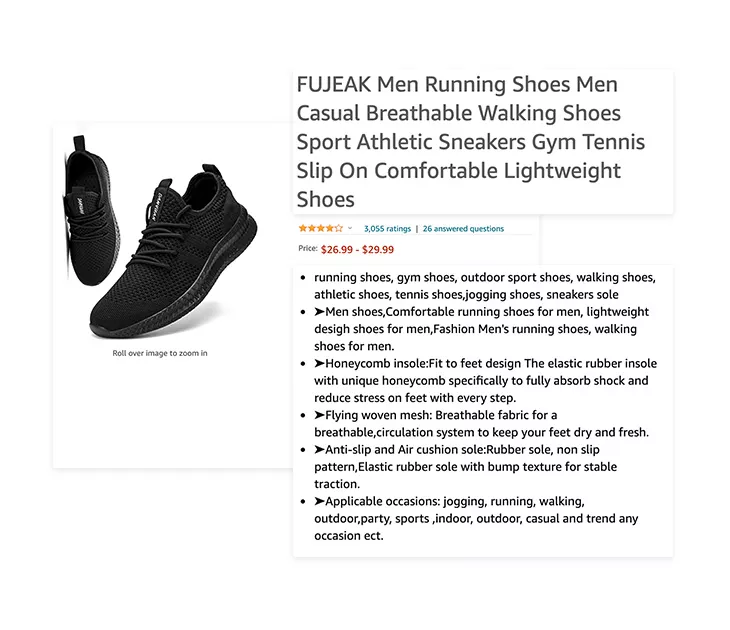
“Women’s Stylish Comfortable Running Sneakers for Gym, Walking, Jogging, Sports – Breathable Mesh, Non-Slip Sole, Lightweight Design, Perfect for All-Day Wear.”
Even the title is overwhelming! It crams in every possible keyword without any sense of flow. Now, let’s look at the description:
“Our running sneakers are made of high-quality breathable mesh and have a durable non-slip sole. They are lightweight, flexible, and suitable for gym, walking, jogging, and other activities.”
Sure, it provides information—but it’s dull, repetitive, and lifeless. It reads like a checklist, not a compelling sales pitch.
How to improve it
A conversion-driven, detailed, and readable description should feel effortless to read. Here’s how we can transform it:
“Move freely and comfortably with our lightweight running sneakers. Designed with breathable mesh to keep your feet cool and a durable non-slip sole for extra stability, these shoes are built for everything—from gym workouts to all-day wear.”
This version maintains all the key information but makes it more engaging, natural, and benefit-driven. This version maintains all the key information but makes it more engaging, natural, and benefit-driven. Tools like AI Humanizer can help rewrite product descriptions to sound more human and relatable, ensuring they improve search visibility while making customers feel genuinely connected to your products—ultimately leading to higher conversions.
By using a tone that feels human and relatable, you create descriptions that not only improve search visibility but also make customers feel connected to your products—ultimately leading to higher conversions.
3. Choose the right keywords
Keywords play a crucial role in making your product descriptions searchable, but using them incorrectly can do more harm than good. Many sellers make the mistake of keyword cramming, stuffing as many terms as possible into a description in hopes of ranking higher. While this might help with search visibility temporarily, it can hurt readability and drive potential customers away.
Let’s take another look at the poorly written shoe description example from before:
“Women’s Stylish Comfortable Running Sneakers for Gym, Walking, Jogging, Sports – Breathable Mesh, Non-Slip Sole, Lightweight Design, Perfect for All-Day Wear.”
While this title includes multiple keywords, it’s clunky, repetitive, and unnatural. The description that follows is just as overloaded with keywords, making it difficult to read and unappealing to customers.
Optimize wisely: balance readability and search rankings
A well-written product description should be both engaging and optimized for search. The key is to write naturally while ensuring your text contains the right keywords. Instead of forcing them in, integrate them seamlessly into the description. Similarly, when students face overwhelming deadlines or research tasks, they may consider options like pay to write my research paper to ensure their work is completed on time and meets high academic standards. For example, imagine a customer is searching for a red women’s dress. This is the type of results that pop up:
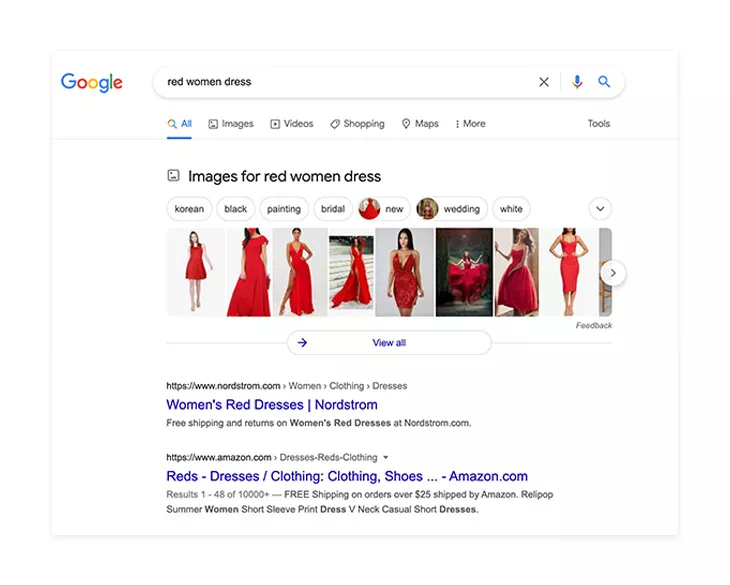
If your product description naturally includes phrases like:
✔ “Designed for elegance, this red women’s dress is perfect for special occasions, offering a flattering fit and soft, breathable fabric.”
instead of
✘ “Red women’s dress elegant style breathable fabric best special occasion dress for women.”
See the difference? The first version flows naturally while still including the essential keywords that improve search visibility.
To give you a little tip, you should use Amazon tools for sellers to help you choose the most relevant keywords for your product descriptions. SEMrush Keyword Overview, Google Keyword Planner, or Ubersuggest by Neil Pattel are just a few examples in this regard.
4. Keep it concise: why less is more in product descriptions
Let’s be honest—no one wants to read a long, boring product description. Customers are busy, and if they have to sift through walls of text, they’ll lose interest fast.
Of course, some products require more detail, but concise, well-structured descriptions boost conversions by keeping the focus on what truly matters.
The Amazon approach: clarity and brevity
Take a look at the biggest online retailer in the world—Amazon. Their product descriptions follow a clear, structured format, rarely exceeding three to four bullet points.
For example, compare these two Amazon listings:
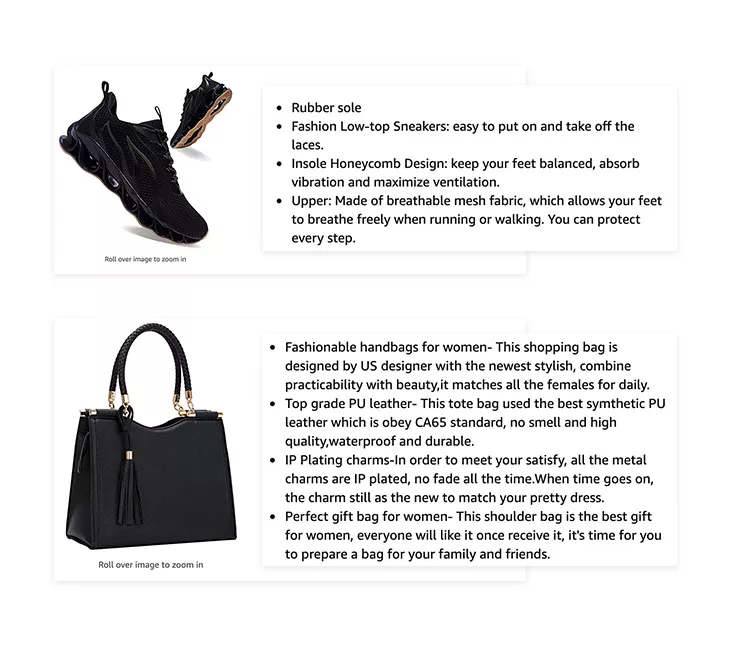
✔ GreHom Handbag – A handbag description example that’s short, structured, and easy to scan.
✘ APRILSPRING Sneakers – A shoe description example that’s cluttered, overly detailed, and harder to read.
Finding the right balance
It’s not just about keeping it short—it’s about making it organized and engaging. If your description is too long, unfocused, or filled with unnecessary details, customers will skim past it or leave the page entirely.
To write a conversion-driven, detailed, yet readable description:
- Highlight only the most important features and benefits
- Use bullet points for easy scanning
- Keep sentences short and to the point
- Maintain a natural, engaging tone
By structuring your product descriptions wisely, you ensure they’re both informative and easy to digest—leading to better customer engagement and higher conversions.
5. Establish trust with social proof
Shoppers don’t just take a brand’s word for it—they look for proof that a product is worth buying. That’s where social proof comes in. Whether it’s customer reviews, ratings, testimonials, or user-generated content, social proof builds credibility and reassures potential buyers that they’re making the right decision.
Why social proof matters
People trust other people more than they trust brands. A product description that says, “This handbag is stylish and durable” carries far less weight than a real customer review saying, “I’ve used this handbag every day for six months, and it still looks brand new!”
Adding social proof to your product descriptions helps:
- Increase trust and credibility
- Reduce purchase hesitation
- Improve conversion rates
How to incorporate social proof into product descriptions
Here are a few ways to make your descriptions more persuasive with social proof:
Highlight customer reviews: If your product has great feedback, integrate a short quote into the description. Example:
“These running shoes are incredibly comfortable! I wear them all day and never feel sore.” – Emily R.
Mention bestsellers and ratings: Example:
“Our top-rated handbag with over 5,000 five-star reviews!”
Use user-generated content: If customers share photos or videos of your product, feature them in your product page to provide real-world validation. Include expert endorsements from industry experts, influencers, or publications that have praised your product; make sure to highlight it in the description.
By weaving social proof into your company and product description, you create a sense of trust that encourages more customers to buy.
6. Keep it clear: why scannable product descriptions sell
When shopping for a product, customers want information fast. They don’t want to wade through long, complex descriptions—they want clear, digestible details that help them make a quick decision.
The more unnecessary information you add, the harder it becomes for customers to process. And when decision fatigue sets in, they’re more likely to abandon the purchase altogether.
How to structure scannable product descriptions
To keep your product descriptions effective and conversion-driven, follow these best practices:
- Use bullet points for key details
- Highlight essential benefits first
- Keep sentences short and to the point
- Break up text with subheadings and whitespace
Flipsnack wholesale catalog example: a clean and structured catalog description
Take this cookware product catalog as an example. It presents kitchen accessories in a visually appealing, well-structured layout, making it easy for customers to browse and find what they need. Instead of lengthy paragraphs, it uses:
- High-quality images to showcase products
- Concise product descriptions that focus on features and benefits
- Interactive shop buttons that streamline the buying process
By keeping product descriptions concise, structured, and scannable, you make it easier for customers to absorb key details and confidently make a purchase.

7. A/B test your product descriptions
Last but not least, don’t forget to split test your product descriptions. This helps you optimize your product page to improve your conversion rate.
Last but not least, don’t forget to split test your product descriptions. Testing different versions of your copy helps you optimize your product page and improve your conversion rate.
Split testing (or A/B testing) is an experiment where you create two different versions of the same product description and compare their performance.
By testing variations in:
- Wording – Do persuasive adjectives increase engagement?
- Length – Do shorter descriptions convert better?
- Format – Do bullet points improve readability?
- Structure – Does emphasizing benefits over features lead to more sales?
Product description example: how formatting impacts conversions
Let’s say you’re selling a white ceramic vase.
Version B: A structured description with a clear headline, bullet points, and white space, making it easier to scan.
Version A: A dense, text-heavy paragraph that overwhelms the reader.
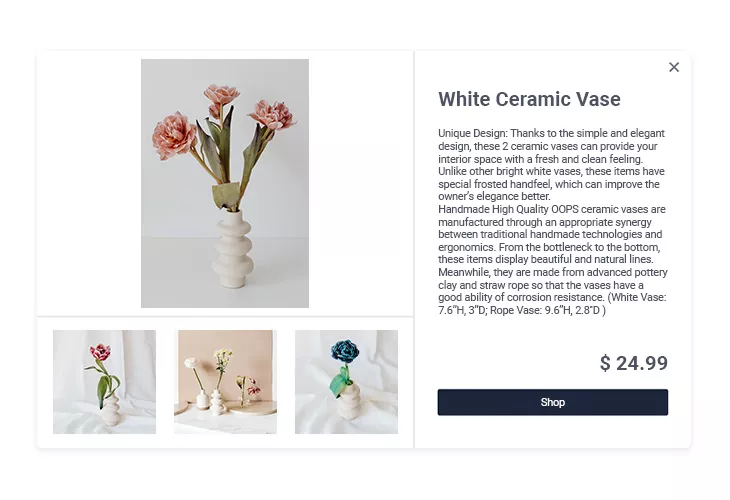
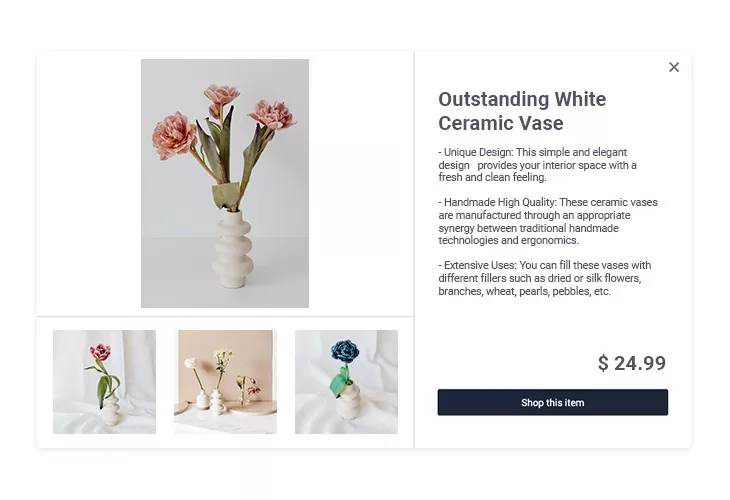
Most of the time, Version B will outperform Version A because it’s easier to read and process quickly—which is exactly what online shoppers prefer.
By continuously split testing and refining your company and product descriptions, you’ll create conversion-driven, detailed, and readable product pages that truly resonate with customers.
Choose Flipsnack to create interactive catalogs
A great product description does more than just describe—it sells. Since online shoppers can’t see or touch your products, they rely entirely on your words to make a decision. That’s why strong, well-structured descriptions are essential for increasing conversions and making your products stand out.
There’s no single formula for writing the perfect company and product description, but the most effective ones follow the same core principles. Focus on the benefits, not just the features. Use keywords wisely to improve search visibility, and make sure descriptions are clear and scannable. High-quality images help, and testing different versions will show you what resonates best with your audience.
Want to take your product presentation even further? A digital catalog lets you showcase your products in a visually interactive way. Flipsnack helps you create professional catalogs that combine compelling descriptions, stunning visuals, and direct shopping links—successuflly attracting and converting more customers.

Frequently asked questions on product descriptions
The ideal length for a product description depends on the product itself, but a good rule of thumb is to keep it concise yet informative. For most e-commerce products, 100-200 words is enough to highlight key features and benefits without overwhelming the reader. However, more complex products may require 300-400 words to provide additional details.
To make product descriptions more engaging, incorporate interactive elements and descriptive storytelling. Using tools like Flipsnack’s shopping feature, you can create shoppable digital catalogs that let customers purchase directly, making the buying process seamless. Additionally, use sensory language and storytelling to create a vivid experience—rather than just listing features, describe how the product feels, looks, or improves daily life to make it more compelling.
Keywords play a crucial role in product descriptions by improving search visibility and helping customers find your products more easily. When used strategically, keywords align with what shoppers are searching for, increasing the chances of your product appearing in search engine results.
